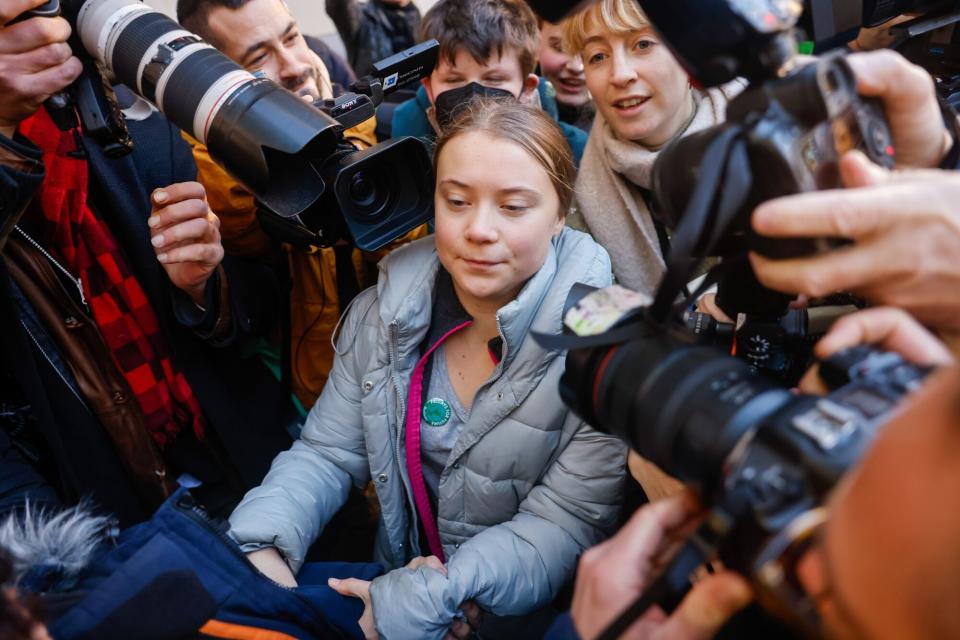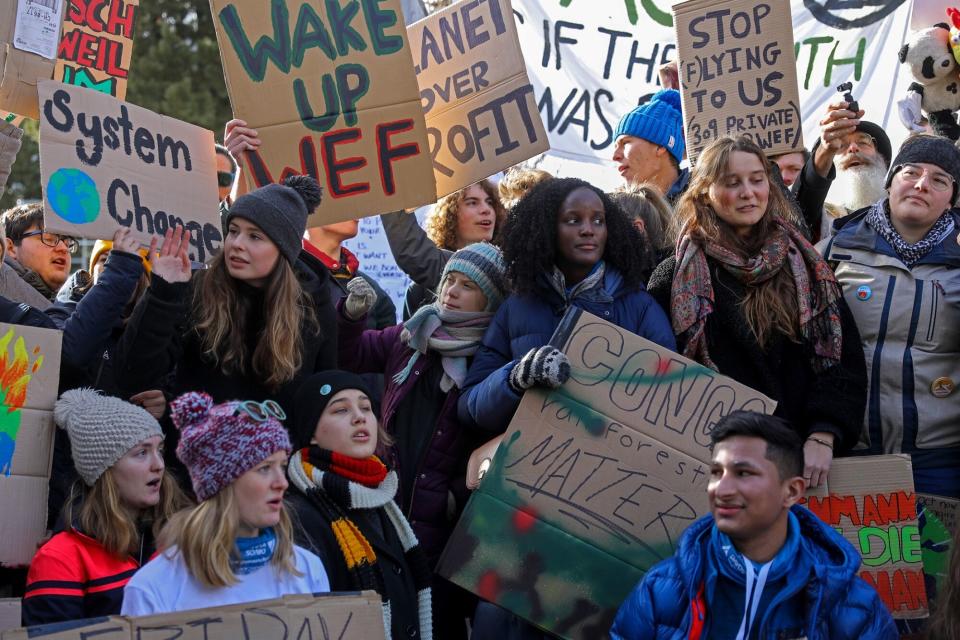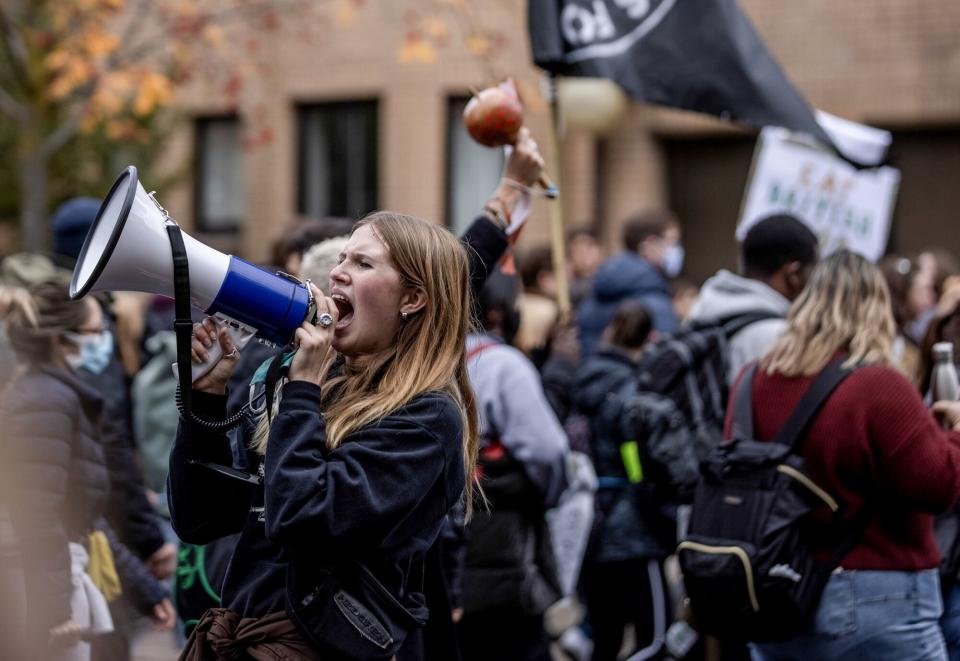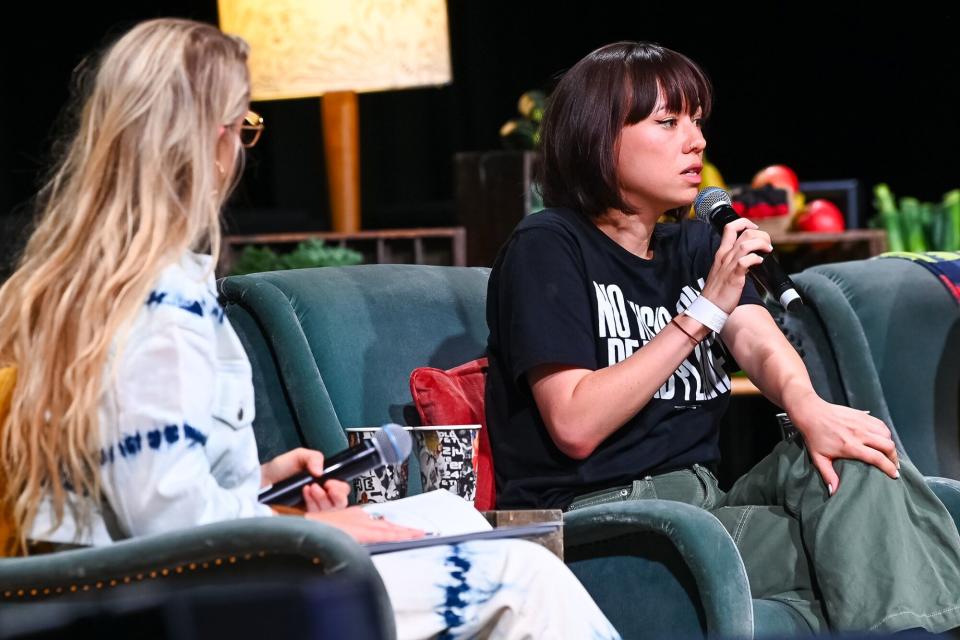Greta Thunberg’s Climate Cohort Is Growing Up
- Oops!Something went wrong.Please try again later.
(Bloomberg) -- COP28 Daily Reports: Sign up for the Green Daily newsletter for comprehensive coverage of the climate summit right in your inbox.
Most Read from Bloomberg
Carlyle’s Rubenstein Is in Talks to Acquire Baltimore Orioles
Elon Musk's SpaceX Valued at $175 Billion or More in Tender Offer
Harvard, Penn Heads Walk Back Genocide Answers After Backlash
Wall Street’s AI Craze Drives Nasdaq 100 Up 1.5%: Markets Wrap
Until recently, Xiye Bastida kicked off every talk she appeared at by telling the audience her age. A New York-based climate activist who started working in the space at 15, Bastida has participated in protests and debated green policies with seasoned professionals. Sometimes a single entreaty from her could be enough to push a roomful of adults toward compromise.
“It was impressive for people to hear that we were so young,” she says. “People listened differently.”
But when Bastida joined a phalanx of young activists at COP28 in Dubai this month, it was as something of an elder stateswoman — or at least an upperclassman. Now 21, she remains part of a high-profile youth climate movement that has shepherded demonstrations and pushed for more accountability on emissions. She is also now older than many of the young activists attending this year’s conference. And at this age, “everybody does stuff,” Bastida says. “Your identity isn’t a youth climate activist anymore.”
Bastida’s is the plight of a generation of young climate advocates who started gaining prominence around 2018, when global attention on youth activism, in her words, “blew up.” Five years, four COPs and 12 months of record-breaking heat later, many of those teens are now young adults — going to college, crafting careers and beginning to navigate the world they devoted their adolescence to bettering. It’s a complicated transition, and one that belies the value of experience: If youth makes people pay attention, how is a youth activist supposed to grow up?
It’s a mid-October morning in London, the first properly cold day of autumn, and activists are blockading an energy conference in the city center. Among them, and top billing in materials sent out to journalists in advance, is Greta Thunberg, the 20-year-old Swede who has become the most famous climate activist in the world. When Thunberg speaks, everyone listens. Camera shutters go off; people stand on tiptoes to see better over the crowd.
Fellow speaker Robin Wells, the director of campaign group Fossil Free London, makes a plea as the press conference wraps up: Please don’t mob Greta with your cameras. “You’ve had your opportunity to speak to her, to have an interview. I do ask you to be respectful,” Wells says. Such appeals follow Thunberg wherever she goes. Here, as in many places, they fall on deaf ears. Fifteen minutes later, there is a throng of photographers around her.
The pandemonium surrounding Thunberg is of a different order than that experienced by most young activists. She was named Time’s Person of the Year in 2019, and has twice been nominated for the Nobel Peace Prize. School climate strikes, which Thunberg started in 2018, have since spread around the world. After Bastida was photographed next to Thunberg (then 16) at the United Nations in 2019, her social media followers jumped from a couple thousand to more than 30,000 practically overnight.
Other aspects of Thunberg’s world are familiar to many young climate activists, who have in recent years joined COP delegations, spoken on panels, appeared on the cover of Vogue, hobnobbed with Leonardo DiCaprio and helped shape actual policy. With that attention comes pressure: to talk to politicians and the media, to have your face and name broadcast across the world, and to spend each day leveraging your youth and vulnerability to persuade more powerful people to change things.
“All I’m thinking about right now is the future,” says 18-year-old activist Alexandria Villaseñor. “How do you break this cycle of constantly growing up and placing it on the youth, growing up and placing it on the youth?”
Teens are in a “liminal space” between babyhood and adulthood, says Benjamin Bowman, a senior lecturer at the Manchester Centre for Youth Studies at Manchester Metropolitan University in the UK. Similarly, young activists are invited into the corridors of power and allowed to break taboos, but not allowed to actually run or control anything. Adults are “able to operate those institutions and processes in a way that admits young people to speak,” Bowman says, “but does not admit those young people to power.”
Girl activists in particular are “simultaneously inspirational and demobilizing,” Jessica Taft, a professor of Latin American and Latino Studies at the University of California at Santa Cruz, wrote in a 2020 study. They symbolize hope, which makes us feel better, while not seeming powerful enough to threaten the status quo.
“Youth are often tapped and brought into spaces to be the moral compass of humanity,” Villaseñor says. “In a way, what it does is it abdicates adults from responsibility.”
After half a decade of activism, last year Villaseñor went back to school. She dropped out of seventh grade in 2018, traveling the world to attend protests and appear on panels. In September 2022, she says she “crash-landed” into a less recognizable world: the classroom of a California high school, where her fellow students were prone to fooling around and talking over the teacher.
“In high school, you loosen up, you’re with your peers, you’re supposed to have fun,” she says. “I’m used to not having fun.”
Villaseñor hasn’t walked away from the climate movement: In 2019 she founded the nonprofit Earth Uprising. But stepping back from the front did give her time to reflect. Young activists are under constant pressure to present a united front, which she describes as a major source of stress, and Villaseñor has experienced death threats, stalkers and public attacks. She also carried on traveling and speaking even when sick, pushing herself to accept every invite with the tenacity of a child championing a righteous cause. As director of Earth Uprising, Villaseñor still joins meetings about the organization’s work, and helped coordinate its plans for both COP28 and end-of-year-projects. But her future plans tend more towards entrepreneurship — starting a company that represents her values rather than trying to find one that aligns with them. “I know that I’m going to have to work,” she says. “And I’m going to have to choose a path that has the least amount of interference.”
“How do you break this cycle of constantly growing up and placing it on the youth, growing up and placing it on the youth?”
She is also enjoying her last moments of being a teen. In addition to applying to college (where she hopes to major in English), Villaseñor recently got her driver’s license, something she was a “little behind on.” Cruising to the beach with family and friends, a routine occurrence for plenty of young people, feels particularly freeing. “It’s been nice to have that time of being a kid,” she says.
In Philadelphia, Bastida is also preparing for life’s next rite of passage: She’s about to graduate from the University of Pennsylvania. For the time being, she lives a dual existence — two days of class per week, interspersed with trips to speak at events and conferences. After being hospitalized for heart palpitations at 17, Bastida now limits herself to two meetings per day, and meditates and exercises regularly. When she does find her way to a college party, people sometimes recognize her as “climate girl.”
Bastida still travels with her mother, and in many ways her work hasn’t changed. She has a documentary about gray whales coming out in May, and will soon go on tour to promote it. After that, she plans to run her nonprofit, Re-Earth Initiative, which operates in 27 countries and raised $1 million this year. But she already feels more pressure to be knowledgeable; after taking a university course in environmental studies, she now goes to conferences and meetings armed with citations from academic literature.
“We made a lot of noise so that we would be invited into these decision-making rooms,” Bastida says. “But if you go into those decision-making rooms and you don't know things, then it discredits all of the work that we did.”
Under some definitions used in the climate movement, “young people” includes anyone up to age 35. But as activists who started young approach their 30s in practice, the association with extreme youth can be difficult to shake.
“We would speak to politicians and journalists and everyone would say, ‘It’s fantastic that you're doing this, your generation is going to save the world,’” says James Miller, 22, a British climate campaigner who started his activism at 13 and now co-hosts a podcast called Here’s the Plan. But those policymakers and executives had the actual power to change things, he says. The effect was to feel that they were “passing that responsibility onto us.”
After graduating from the University of Cambridge this year, Miller moved back in with his parents outside London and is now weighing next steps. An entry-level role in law or at a sustainability consultancy is one option, but it’s complicated. “When you are so acutely aware of how urgent the climate and the biodiversity crisis are,” he says, “to be in a job where you don’t feel you’re having the influence that you could right from the get-go, is quite frustrating.”
During a recent on-stage discussion at London’s Southbank Centre — billed as a conversation between young climate leaders — Thunberg, at 20, was the youngest. The others were all women in their 20s, adults who had in many cases started their work as children. Outside, protesters mocked Thunberg by name, a reminder of the notoriety that follows her everywhere.
One of the panelists, Tori Tsui, 29, who lives in Bristol, UK, says even friends her own age sometimes forget she isn’t younger. That’s in part because of the association between climate activism and Gen Z, a cohort now aged roughly 10 to 25 that includes many prominent climate activists, including Thunberg, Villaseñor and Bastida.
“I did have to forfeit my youth, and maybe I come across as younger,” Tsui says. “Not only because of the way in which I talk about the climate crisis and the affiliations with Gen Z, but also I probably haven’t lived my life like a normal 20-something.”
Tsui has told friends that this is “the last year that I’m doing anything in youth spaces.” In 2022, she participated in the aforementioned Vogue photoshoot with the 21-year-old pop star Billie Eilish and some fellow climate activists, a few of whom were as young as 16. “I felt so uncomfortable the whole time,” Tsui says. “I was like, ‘Am I a fraud? Should I be passing the mic here?’”
Some activists are making a point to work with the next wave of young people. Joshua Amponsem, 32, has been in the climate space for more than a decade. In 2020, he developed a youth program for the UN’s Global Commission on Adaptation and subsequently worked with the UN’s youth envoy on engaging young people. The move gave him a chance to help a new generation speak at events and influence policy. It also meant moderating his own speech for the first time, lest it be interpreted as the official opinion of the UN. “Instead of being invited as a speaker, now I was the one who creates the program and looks for a speaker,” Amponsem says.
Vanessa Nakate, 27, was about to graduate from college in Kampala, Uganda, when she became an activist in 2019. She says she sometimes felt like an interloper amongst all the teenagers. The Fridays for Future movement, started by Thunberg, involved schoolchildren striking from classes; Nakate started Youth for Future as a way for young adults to strike, too.
Today Nakate is focused on helping activists develop careers once they age out of “youth” and want to pay their bills while also keeping their voice. “We really need to have that conversation of what happens when people stop being youth activists,” Nakate says. “Because I don't think there's enough space for people to actively speak as much as they want when they start to get into organizations or companies.”
A central ambition Nakate has for her own nonprofit, the Rise Up Movement, is to offer this kind of institutional support. That’s also how she sees her career developing — as a sure, steady resource for activists at any age. “The planet doesn't stop being my home when I turn 30,” Nakate says. “It is my home as long as I exist in this space.”
Most Read from Bloomberg Businessweek
Salesforce Signals the Golden Age of Cushy Tech Jobs Is Over
How the Biggest Boutique Fitness Company Turned Suburban Moms Into Bankrupt Franchisees
Hottest Job in US Pays $80,000 a Year, No College Degree Needed
SpaceX’s Colossal Starship Sets Pace in Race to Build Larger Rockets
The Untold Story of a Massive Hack at HHS in Covid’s Early Days
©2023 Bloomberg L.P.






